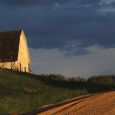The Gift of South Dakota
Subscriptions to South Dakota Magazine make great gifts!
Subscribe today — 1 year (6 issues) is just $29!
The Spirituality of Hanson County
Aug 11, 2015
 |
At 435 square miles, Hanson County is the third smallest county in South Dakota. But what it lacks in area, it makes up for in spirituality. The lazy James River quietly runs through the southwestern quarter, past the graves of two men who died defending their staunchly held religious beliefs. In Alexandria you’ll find a shrine dedicated to a modern miracle. And in between the lakes, fields and streams provide ample opportunities to reconnect with nature.
Most visitors will arrive in Hanson County driving 80 mph on Interstate 90, but that’s the fastest pace you’ll find here. Exit at Alexandria and spend a few quiet moments at the Fatima Family Shrine, an elaborate exhibit of Catholic statuary started in 1987. It pays tribute to the 1917 appearance of the Virgin Mary to three shepherd children at Fatima, Portugal. The shrine features an image of Mary modeled after the statue at Fatima. At the base is Portuguese rock and soil from the very ground by the oak tree on which Mary was seen.
 |
| St. Mary of Mercy Church in Alexandria. |
The shrine is next to Alexandria’s historic St. Mary of Mercy Catholic Church. Across the street is a cloistered convent called the Monastery of Our Mother of Mercy, where 14 Carmelite nuns work and pray for world peace in relative isolation from the public.
Another powerful spot is burial site of Michael and Joseph Hofer, two Hutterites who died after refusing to fight during World War I. They rest in the cemetery at Rockport Colony, 8 miles southwest of Alexandria. The Hofers were drafted in 1918, but as pacifists they were conflicted. After consultation with elders, they decided to report for training but to abstain from any activity that furthered the war effort.
They were jailed, taunted, beaten and starved until they both contracted pneumonia inside the prison at Fort Leavenworth, Kansas. The Hofers died within days of each other. Their bodies were returned to Rockport and buried in the tiny colony cemetery.
Today the story of the Hofers is well known among the North American Hutterite community, though few others are aware. Hutterite children learn about the brothers as schoolchildren, and families from across the continent come to Rockport to pay their respects at the grave.
 |
| Michael Hofer's gravesite at Rockport Colony. |
Rockport Colony sits on the very first townsite in Hanson County. The first settlement grew in 1865 when the U.S. military sent soldiers to keep peace between Indians and encroaching settlers. The men used quartzite, which is plentiful along the banks of the James River around Rockport, to build Fort James, one of the only stone cavalry forts in the West.
Fort James was occupied for only two years. All that remains are quartzite foundations and a marker placed at the site following an archaeological investigation of the area several years ago.
Hanson County was originally created in 1871 and named for Major Joseph R. Hanson, one of Yankton’s earliest residents. Hanson was born in New Hampshire and moved west seeking better business opportunities. He arrived at Sioux City in 1858, crossed into Nebraska and set up a winter camp just across the Missouri River from present day Yankton. At the time, only four white men lived in the area, and all worked at the Frost, Todd and Company trading post.
 |
| Fort James was occupied in 1865 and 1866. |
Longtime state historian Doane Robinson credits Hanson as being the second actual settler of Yankton behind John Holman, who had built a cabin there a month before Hanson’s arrival. He served two years as chief clerk of the territorial legislature and helped secure the fledging town against Indian raids by direction construction of the Yankton stockade in 1862. Hanson became a prominent citizen with a successful farm just east of town.
The first civil settlement in Hanson County occurred at Rockport, when Peter, Samuel and Michael Bloom, Jerry Flick and Frank Foster arrived in 1872. A small post office was built and a town platted in 1878 in preparation for Rockport’s designation as county seat. But the county’s boundaries were adjusted in 1879 and the railroad chose a route through Alexandria. Voters moved the county seat to Alexandria after the election of 1880. Rockport became the site of a Hutterite colony in 1894 and remained so until 1918, when nearly all Hutterites in North America moved to Canada in opposition to the war. The present Rockport Colony was created in 1934.
 |
| Lake Hanson, southwest of Alexandria. Photo by Christian Begeman. |
In that same year, the Depression-era Works Progress Administration built a dam along Pierre Creek 2 miles southwest of Alexandria. The resulting impoundment became known as Lake Hanson, a popular spot for water recreation. Another fishing hole is Long Lake, just north of Farmer. Anglers catch bluegill, sunfish and largemouth bass there.
Hanson County is largely rural. Alexandria is its largest town, at about 630 people. Emery, just southeast along Highway 262, is a town of 450 people. In Fulton (pop. 94) sisters Mary Wipf and Elizabeth Soladay run Con Brio Studio, a business specializing in restoring and re-hairing bows for stringed instruments. Only 10 people call Farmer home, but the community still manages to hold a grand antique tractor parade the weekend following Labor Day. Their slow procession contrasts starkly to the traffic zooming along I-90 just 5 miles south. Maybe those cars should get off the freeway and experience the laid back and reflective life that Hanson County can offer.
Editor’s Note: This is the eighth installment in an ongoing series featuring South Dakota’s 66 counties. Click here for previous articles.










Comments
What wonderful memories I have of living on our farm, attending the small rural school Wayne 1 where all of us kids attended as did my father and then attending Alexandria High School. I went from a class of five to a class of I believe 42. Good times that I wish I could go back to again.
Until his death in 1990
He too was very active in the St Martins Luteran church. They raised 9 children. My 3 brothers still live in Alexandria
Tom carried on the plumbing. Dennis worked for the city. Roger worked for Hanson County.
And are all retired.
My mother of 94 is living on her own in Mitchell, SD. Alexandria is a very small knit community.
I attended a one room country school for 4 years before the county incorporated and we had to go to "town school".
It was a great place to grow up. I have three sisters. Jolene, my older sister, lives on the farm. My younger sisters, Lee and Peggy, both live in Minn. I live in Lincoln, Ne.
Born 5 November 1897 in Germany
He was confirmed at St Martini (Martins) Lutheran Church - Section 5, Taylor Township, Hanson County, SD - on 13 Marz/March 1913.
My family has the original confirmation certificate as signed by Rev. G H J Hubert who was there in 1913 (from 1907-1914)
I understand that the church moved into Alexandria on 9mar1931 and that the country church is long gone with only a cemetery there now. (right?)
does anyone have a picture of that old country church that served until c1931
BTW the Johann & Minnie Hamann that are buried there are my relatives as well.
Thanks in advance
Brent Friedrichs - former missionary to Africa - Director of missionary support GLO.
FriedrichsBL@yahoo.com